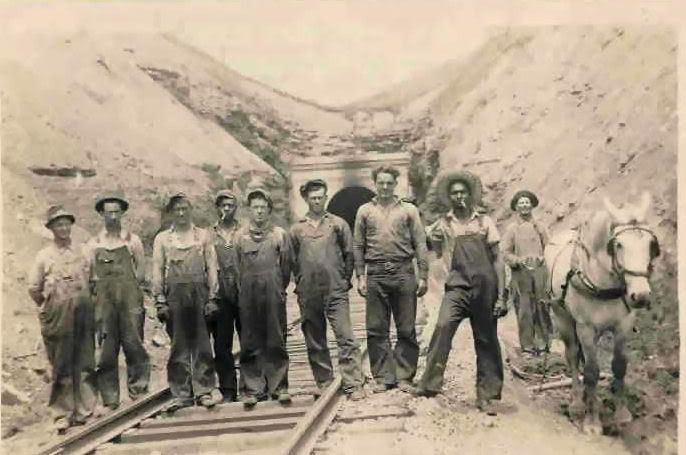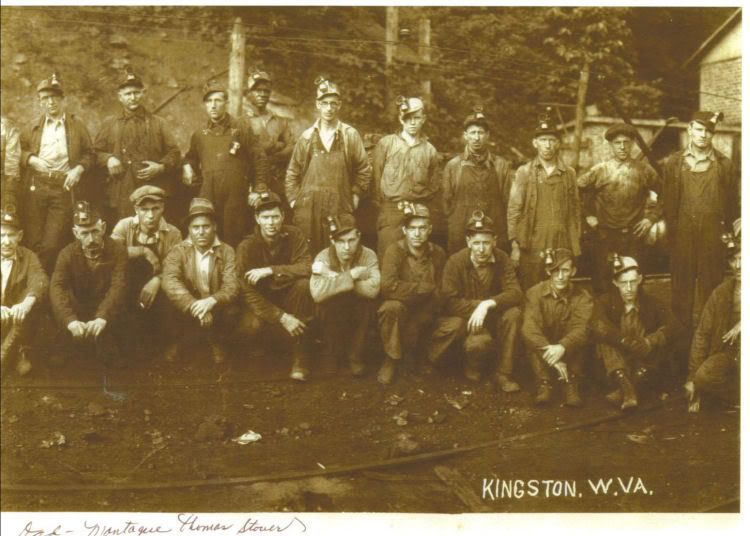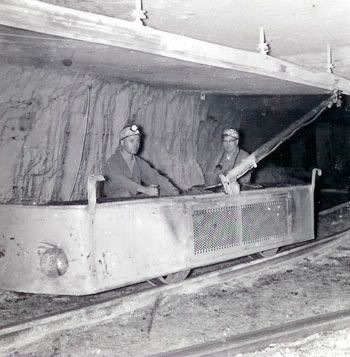Coal Mining in West Virginia
(from http://www.wvgs.wvnet.edu/www/geology/geoldvco.htm)

Miners in Raleigh County
It wasn't until the mid 1800's that coal mining began to be a major industy in West Virginia. Until that time, although coal was known to exist in West Virginia, there wasn't a real need to mine it because of the abundance of wood and lack of coal manufacturing industries. In 1810, people of Wheeling began to use coal from a nearby mine to heat their homes. In 1811, the first steamboat on the Ohio burned coal from the Ohio banks. By 1817, coal began to replace charcoal as fuel for many Kanawha River salt furnaces. in 1836, due to the enormous amount of attention given to the western Virginia coal fields, Professor William B Rogers, Virginia's foremost geologist, was sent to the mines to analyze the coal in eight counties. By 1840, the total coal production was up to 300,000 tons. Between 1840 and 1860, many coal companies were organized and corporations were established under the laws of Virginia to encourage financial investments from foreign countries.
When the Civil War broke out, the Kanawha Valley mines were closed. Many of the dams along the river were destroyed and confederate troops set up camps in the valley, preventing shipping. The Elkins and Fairmont coal fields in the north remained active, providing coal for the Union.

Fayette County, West Virginia miners
After the Civil War, renewed interest in the state's mineral resources brought new growth and development of the coal industry. By 1880 there were extensive operations in Mineral, Monongalia, Marion, Fayette, Harrison, Ohio, Putnam, and Mason counties. In 1901, the Fairmont Coal Company was formed, which later became the Consolidation Coal Company. Many of the coal mines owed their success to the Chesapeake and Ohio Railway. As the railroad grew, the coal became more available for marketing, making the coal fields prosper.
As the coal industry grew, mining methods and laws changed rapidly. In the earliest days, local farmers and slaves surface mined the coal, using picks and shovels to remove the overburden. The coal was then dug out, shoveled into baskets and sacks, and carried away. Later, sleds, wheelbarrows, and carts came into use in deep mining, hauled by oxen, mules, goats, dogs, and sometimes men. Progress in mechanization was slow, as operators did not want to pay for expensive new equipment, and miners feared being replaced by it. Also, many felt that the old bank mule was more reliable. By 1890, however, electric coal cutting, loading, and hauling machines came into use, and mules were used less frequently. After 1936, mechanization went forward very rapidly, with shuttle cars, long trains, conveyor belts, and all kinds of large mining machinery coming into common use. Large-scale surface mining did not start until 1914, but with the development of huge shovels and draglines, the overburden can now be removed more easily and in recent years this method has become a major method of mining coal in West Virginia. Two peaks occurred in West Virginia's coal production: in 1927 production reached 146,088,121 tons and in 1947 it peaked at 173,653,816 tons. (from http://www.wvgs.wvnet.edu/www/geology/geoldvco.htm)
Because the coal mines were often located far from towns, the coal companies often built their own coal company towns, complete with company stores, affordable housing, churches, and sometimes even recreational facilities for the miners and their families. A method of bookkeeping using coal scrip (tokens) was even established, due to the miners' daily needs. Miners could get an advance credit on their salary in scrip to buy necessities from the company store. Each mine had its own scrip symbol on the tokens, which could only be used at the local company store.

As the coal industry continued to grow, many of the coal companies began to be run by out of state superintendents and being supported by out of state capital. Immigrants from Wales, Scotland and England were brought over to work in the coal mines. The superintendents brought over cheap foreign labor and often abused them with poor medical care, long working hours and inferior living conditions in general. The poor working conditions in the mines brought about the first West Virginia coal mining legislation in 1883. This legislation appointed a state mine inspector who was to inspect all mines for adequate safety conditions. The state union of United Mine Workers of America was established in 1890 in Wheeling to push for better working conditions. The West Virginia Department of Mines was created in 1905 to enforce inspection laws. However, it wasn't until the Franklin D Roosevelt era that the federal goverment stepped in to help the miners. The National Industrial Recovery Act established an 8-hour work day and a minimum wage provision. The act was later declared unconstitutional, but by then most of the mining companies had unionized. Since the 1930's, the union has been a force in providing for the welfare, retirement and other benefits for miners.





2 Comments:
Hey Hey
Sure glad someone took time to let people know that West Virginia sure is a great state and has many things to do and see.
I was born in Brandywine an very proud to be a Hillbilly!
R.W.Bennett (Cricket)
Is there any identity of the coal miners from Kingston, WV? What year the photo was taken?
Post a Comment
Subscribe to Post Comments [Atom]
<< Home